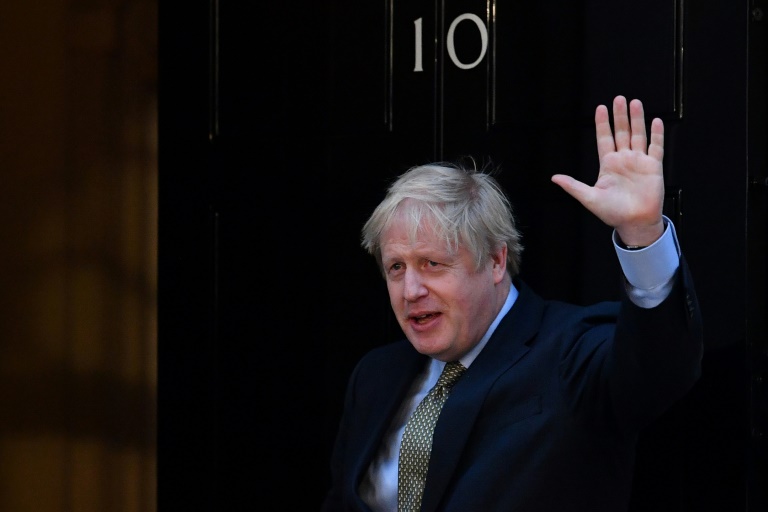Prime Minister Boris Johnson got down to work Monday following his sweeping election victory, appointing ministers and announcing plans to publish legislation this week to get Britain out of the European Union.
The Conservative leader will present a bill on Friday that begins the process of ratifying the divorce terms he struck with Brussels in October, his spokesman said.
Read Also: UN Chief Calls Climate Summit A ‘Lost Opportunity’
Johnson won a landslide in Thursday’s general election after promising to “Get Brexit Done” and end Britain’s EU membership after years of acrimonious political debate.
 AFP / ISABEL INFANTESJeremy Corbyn led the Labour party to its worst electoral defeat since before World War II
AFP / ISABEL INFANTESJeremy Corbyn led the Labour party to its worst electoral defeat since before World War II“The government has just been elected with a clear majority to deliver Brexit, and we’re focused on passing the legislation to ensure that happens by January 31,” the spokesman said.
Johnson is expected to wait until February to overhaul his cabinet, but filled two ministerial posts on Monday made vacant by resignations before the election.
For many in Britain, the poll became a re-run of Britain’s 2016 EU membership referendum.
A narrow majority had opted to leave the EU back then but the vote was followed by bitter rows in parliament over how — or even if — Britain should end almost five decades of integration with its closest neighbours.
Johnson declared the argument settled when his Conservatives won 44 percent of the vote on Thursday, giving it a majority of 80 in the 650-seat Commons — its biggest since the heyday of Margaret Thatcher in the 1980s.
The main opposition Labour party meanwhile was relegated to its worst defeat since before World War II, forcing leader Jeremy Corbyn to announce a plan for his departure.
– Canada-style deal –
In his first ministerial appointment, Johnson announced that Nicky Morgan, who quit as culture minister after deciding not to stand again as an MP in last week’s vote, would stay on in the job as a member of the House of Lords.
He also announced a new Wales minister, after the former occupant quit last month.
He is expected to conduct a real overhaul once the first stage of Brexit is safely out of the way.
London and Brussels will then have to embark on yet more negotiations aimed at striking new trade and security partnership.
 AFP/File / DANIEL SORABJIPrime Minister Boris Johnson’s immediate focus is on a new government agenda that is expected to focus heavily on social spending
AFP/File / DANIEL SORABJIPrime Minister Boris Johnson’s immediate focus is on a new government agenda that is expected to focus heavily on social spendingThe withdrawal deal sets out a post-Brexit transition period until the end of 2020 to hold these talks, during which time UK-EU ties will remain broadly the same.
London has the option to extend the transition but Johnson has insisted this will not happen, saying it is time to break free of EU rules.
His spokesman repeated on Monday that he would be seeking a “Canada-style free trade agreement”, similar to the recent deal signed between the EU and Canada.
But EU officials caution that trade deals can take years and experts warn that failure to reach agreement before the transition ends could lead to a severe economic shock.
Johnson also wants a trade deal with the United States after Brexit.
He spoke to US President Donald Trump on Monday about plans for an “ambitious” new agreement, No 10 said.
– Locking in Labour votes –
Johnson later welcomed the 109 newly-elected Conservative MPs to parliament, ahead of the formal swearing-in ceremony that begins on Tuesday.
The Tories won the election by taking a swathe of northern English and Welsh seats from the Labour party, reshaping the political landscape.
One new MP, Aaron Bell, who won in the north-eastern English seat of Newcastle-under-Lyme, tweeted a picture of himself opposite Westminster.
“A new dawn has broken, has it not?” he wrote. The Labour party’s Tony Blair said the same phrase when he won a landslide election victory in 1997.
On Thursday, Queen Elizabeth II will read out Johnson’s legislative programme in a ceremony in parliament, setting out his government’s priorities.
Aside from Brexit, it is expected to focus heavily on social spending aimed at locking in the future votes of traditional Labour supporters who switched sides.
After nine years of Conservative governments focused on cutting public spending, Johnson has promised more money for schools, hospitals, police and infrastructure.

